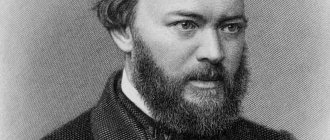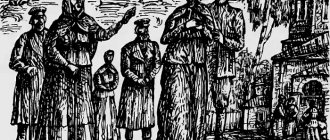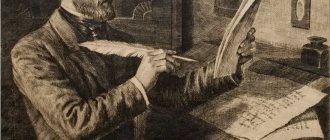Introduction
The dramatic play in five acts “The Thunderstorm” by A. N. Ostrovsky is the pinnacle of the writer’s creativity, at the same time, it is one of the works that is included in the treasury of the Russian literary heritage. The central theme of the play is a socio-historical conflict, a crisis in the confrontation between two worlds: the old patriarchal and the new, filled with bright hopes for the future. The bearers of the psychology of both worlds are the main characters of the work.
The drama was completed in 1859. The idea of writing it was born under the impression of a trip along the Volga, when the writer collected various everyday stories in the cities in which he stopped. The plot was based on a real story in the Klykov family of philistines, in which the daughter-in-law, driven to despair by her mother-in-law, committed suicide by drowning herself in the Volga. It was the relationships in such a family that became the basis of the play.
For people of that era, such phenomena were not something secret. Almost everyone knew that such things were happening in most Russian petty-bourgeois families. The merit of the writer is that he brought the issue to public attention and showed that it exists. And the fact that it exists is wrong and unacceptable. That is why the play evoked such a wide response among theater and reading audiences.
In the drama, the writer discovered a new “philosophy of everyday life” for Russian literature, the essence of which is that everyday life is a form of life, a mirror reflection of a person’s aspirations.
History of the play
The analysis of “The Thunderstorm” should begin with the history of its writing, because the circumstances of that time played an important role in the creation of the plot. The play was written in 1859 during Ostrovsky's travels around the Volga region. The writer observed and explored not only the beauty of nature and the sights of the Volga region cities.
He was no less interested in the people he met on his journey. He studied their characters, everyday life, and their life stories. Alexander Nikolaevich took notes, and then based on them he created his work.
But the story of the creation of Ostrovsky’s “Thunderstorm” has different versions. For a very long time they were of the opinion that the writer took the plot for the play from real life. There lived a girl in Kostroma who, unable to withstand her mother-in-law’s oppression, threw herself into the river.
Researchers found many matches. This happened in the same year in which the play was written. Both girls were young and were married off at a very early age. Both were oppressed by their mothers-in-law, and their husbands were weak-willed. Katerina had an affair with the nephew of the most influential man in the city, and a poor Kostroma girl had an affair with a postal employee. It is not surprising that due to such a large number of coincidences, for a long time everyone believed that the plot was based on real events.
But more detailed studies have refuted this theory. Ostrovsky sent the play to print in October, and the girl dropped out a month later. Therefore, the plot could not be based on the life story of this Kostroma family. However, perhaps, thanks to his powers of observation, Alexander Nikolaevich was able to predict this sad end. But the story of the creation of the play also has a more romantic version.
History of writing
Inspired by the beauty of the Volga region and its endless expanses during a trip with his family to Kostroma in 1848, Ostrovsky began writing the play in July 1859, three months later he finished it and sent it to the St. Petersburg censor.
Having worked for several years in the office of the Moscow Conscientious Court, he knew well what the merchant class was like in Zamoskvorechye (the historical district of the capital, on the right bank of the Moscow River), more than once having encountered in his service what was going on behind the high fences of the merchant choirs , namely with cruelty, tyranny, ignorance and various superstitions, illegal transactions and scams, tears and suffering of others. The basis for the plot of the play was the tragic fate of the daughter-in-law in the wealthy merchant family of the Klykovs, which happened in reality: a young woman rushed into the Volga and drowned, unable to withstand oppression from her domineering mother-in-law, tired of her husband’s spinelessness and secret passion for a postal employee. Many believed that it was the stories from the life of the Kostroma merchants that became the prototype for the plot of the play written by Ostrovsky.
In November 1859, the play was performed on the stage of the Maly Academic Theater in Moscow, and in December of the same year at the Alexandrinsky Drama Theater in St. Petersburg.
Read more: A.N. Ostrovsky “The Thunderstorm”: the history of the play
Who was the prototype for the main character?
In the analysis of “The Thunderstorm,” one can also point out that there were many disputes about who the image of Katerina was copied from. There was also room for the writer’s personal drama. Both Alexander Nikolaevich and Lyubov Pavlovna Kositskaya had families. And this served as an obstacle to the further development of their relationship.
Kositskaya was a theater actress, and many believe that she is the prototype of the image of Katerina in Ostrovsky’s “The Thunderstorm.” Later, Lyubov Pavlovna will play her role. The woman herself was from the Volga region, and the playwright’s biographers wrote that “Katerina’s Dream” was written down from Kositskaya’s words. Lyubov Kositskaya, like Katerina, was a believer and loved the church very much.
But “The Thunderstorm” is not only a drama about personal relationships, it is a play about the growing conflict in society. In that era there were already people who wanted to change the old order, but the ossified “Domostroevsky” society did not want to obey them. And this confrontation is reflected in Ostrovsky’s play.
Option 2
In 1856, when A. N. Ostrovsky was writing one of his stories, an interesting character appeared in his manuscripts - a despotic merchant’s wife. The image of the future Kabanikha waited for its incarnation for another three years.
Work on the play “The Thunderstorm” began in the summer of 1859. At this time, the author had just completed an ethnographic expedition along the Volga River. He colorfully described the valuable knowledge about the customs and morals of the Volga population, acquired during the trip, in a new play. Kalinov, in which the events of the play unfolded, was composed of small details of many cities that Ostrovsky encountered. Ostrovsky's characters inherited the characters of the people the author met. During the expedition, the author became an involuntary witness to everyday scenes and dialogues of local residents. He described some of them in the play and left them unchanged. The play “The Thunderstorm” can safely be called a rich ethnographic sketch of the author’s impressions.
The image of the main character Katerina had a real prototype, it was the actress Lyubov Kositskaya. The play displays some facts of her biography, her reverent attitude towards faith, and even captures the plot of her dream. Later, Kositskaya played Katerina herself on the theater stage, becoming the first performer of this role. Ostrovsky had a close personal relationship with the actress, but since both were not free, a common future was impossible.
For a long time it was believed that Ostrovsky simply described a real incident that occurred in Kostroma, in the Klykov family. The deceased girl Alexandra also had an affair and a stern, domineering mother-in-law. But, as it turned out, the death of a local resident under similar circumstances occurred after the author had sent the play to print. Perhaps there were other reasons for her death, but it was impossible to find out.
At the time of writing the play, Ostrovsky was very worried about the invisible confrontation that was brewing in society. “The Thunderstorm” is about the first, unique individuals who wanted to quickly move away from the old, constraining order.
The play, based on the spiritual culture of the Volga region inhabitants and Ostrovsky’s personal drama, was completed in October 1859. In the same year, viewers saw her first production on the theater stage. “The Thunderstorm” received different responses. However, no one remained indifferent to this tragedy, the difficult dramatic conflict of a young woman. The author was able to create a concise work that touches on important topics for every person.
Grade 10
Other works: ← The city of Kalinov and its inhabitants↑ OstrovskyThe suicide of Katerina in the Thunderstorm →
Summary of Ostrovsky's "Thunderstorm"
The play takes place in the fictional Volga city of Kalinov. The inhabitants of this town are people accustomed to deception, tyranny, and ignorance. Several people from the Kalinovsky society stood out for their desire for a better life - these are Katerina Kabanova, Boris and Kuligin.
The young girl was married to the weak-willed Tikhon, whose stern and oppressive mother constantly oppressed the girl. Kabanikha established very strict rules in her house, so all members of the Kabanov family did not like her and were afraid of her. During Tikhon's departure on business, Katerina secretly meets with Boris, an educated young man who came from another city to visit his uncle, Dikiy, a man of the same tough character as Kabanikha.
When her husband returned, the young woman stopped seeing Boris. She feared punishment for her action because she was pious. Despite all the persuasion, Katerina confessed everything to Tikhon and his mother. The boar began to tyrannize the young woman even more. Boris's uncle sent him to Siberia. Katerina, having said goodbye to him, rushed into the Volga, realizing that she could no longer live in tyranny. Tikhon accused his mother that it was because of her attitude that his wife decided to take such a step. This is a summary of Ostrovsky's "The Thunderstorm".
Brief description of the characters
The next point in the analysis of the play is the characteristics of the heroes of Ostrovsky’s “The Thunderstorm”. All the characters turned out to be memorable, with bright characters. The main character (Katerina) is a young woman brought up in the house-building order. But she understood the rigidity of these views and strived for a better life, where all people would live honestly and do the right thing. She was devout and loved to go to church and pray.
Kabanova Marfa Ignatievna is a widow, a wealthy merchant. She adhered to the principles of house building. She had a bad temper and established tyrannical rules in the house. Tikhon, her son, a weak-willed man, loved to drink. He understood that his mother was unfair to his wife, but was afraid to go against her will.
Boris, an educated young man, came so that Dikoy would give him part of the inheritance. He is impressionable and does not accept the laws of Kalinov society. Dikoy is an influential man, everyone was afraid of him because they knew what a harsh character he had. Kuligin is a tradesman who believes in the power of science. Tries to prove to others the importance of scientific discoveries.
This is a characteristic of the heroes of Ostrovsky’s “The Thunderstorm”, who played a significant role in the plot. They can be divided into two small societies: those who held the old views and those who believed that change was necessary to create better conditions.
Ray of light in the play
In the analysis of "The Thunderstorm" it is worth highlighting the main female character - Katerina Kabanova. It is a reflection of what tyranny and despotic attitudes can do to a person. The young woman, although she grew up in the “old” society, unlike the majority, sees the injustice of such orders. But Katerina was honest, she did not want and did not know how to deceive, and this is one of the reasons why she told her husband everything. And those people who surrounded her were accustomed to deceiving, fearing, and tyrannizing. But the young woman could not accept this; all her spiritual purity opposed it. Because of the inner light and the desire to live honestly, the image of Katerina from Ostrovsky’s “The Thunderstorm” was compared to “a ray of light in a dark kingdom.”
And the only joys in her life were prayer and love for Boris. Unlike all those who talked about faith, Katerina believed in the power of prayer, she was very afraid of committing a sin, so she could not meet with Boris. The young woman understood that after her act, her mother-in-law would torment her even more. Katerina saw that in this society no one wanted to change, and she could not live among injustice, misunderstanding and without love. Therefore, throwing herself into the river seemed to her the only way out. As Kuligin later said, she found peace.
Quotes
“They don’t really respect elders these days” Kabanikh .
“No, they say, it’s just his own mind. And that means live as someone else’s.” Tikhon Kabanov .
“Whatever I want, I’ll do” Katerina.
“Know your business - be silent if you don’t know anything better” Varvara .
“In your city there is paradise and silence, but in other cities it’s just sodomy, mother: noise, running around, incessant driving!” Feklusha.
Read more: A.N. Ostrovsky “The Thunderstorm”: quotes from the characters and the author of the play
Image of a thunderstorm
In the play, some of the important episodes are associated with a thunderstorm. According to the plot, Katerina was very afraid of this natural phenomenon. Because people believed that a thunderstorm would punish a sinful person. And all these clouds, thunder - all this only intensified the depressing atmosphere of the Kabanovs’ house.
In the analysis of “The Thunderstorm,” it should also be noted that it is very symbolic that all episodes with this natural phenomenon are connected with Katerina. This is a reflection of her inner world, the tension in which she was, the storm of feelings that raged inside her. Katerina was afraid of this intensity of feelings, so she was very worried when there was a thunderstorm. Also, thunder and rain are a symbol of purification; when the young woman threw herself into the river, she found peace. Just like nature seems cleaner after rain.
The main idea of the play
What is the main meaning of Ostrovsky's "Thunderstorm"? The playwright sought to show how unfair society is structured. How they can oppress the weak and defenseless, leaving people no choice. Perhaps Alexander Nikolaevich wanted to show that society should reconsider its views. The meaning of Ostrovsky's "The Thunderstorm" is that one cannot live in ignorance, lies and rigidity. We must strive to become better, to treat people more tolerantly, so that their life does not resemble the “dark kingdom”, like Katerina Kabanova’s.
Personality conflict
The play shows the growth of Katerina's internal conflict. On the one hand - the understanding that it is impossible to live in tyranny, love for Boris. On the other hand, strict upbringing, a sense of duty and fear of committing a sin. A woman cannot come to one decision. Throughout the play, she meets with Boris, but does not even think about leaving her husband.
The conflict is growing, and the impetus for Katerina’s sad death was separation from Boris and increased persecution from her mother-in-law. But personal conflict does not occupy the most important place in the play.
Features of compositional construction
(Fragment from a dramatic production)
The work begins with a description of the city on the Volga Kalinov, the image of which is a collective image of all Russian cities of that time. The landscape of the Volga expanses depicted in the play contrasts with the musty, dull and gloomy atmosphere of life in this city, which is emphasized by the dead isolation of the life of its inhabitants, their underdevelopment, dullness and wild lack of education. The author described the general state of city life as if before a thunderstorm, when the old, dilapidated way of life will be shaken, and new and progressive trends, like a gust of furious thunderstorm wind, will sweep away the outdated rules and prejudices that prevent people from living normally. The period of life of the residents of the city of Kalinov described in the play is precisely in a state when outwardly everything looks calm, but this is only the calm before the coming storm.
The genre of the play can be interpreted as a social drama, as well as a tragedy. The first is characterized by the use of a thorough description of living conditions, the maximum transfer of its “density,” as well as the alignment of characters. Readers' attention should be distributed among all participants in the production. The interpretation of the play as a tragedy presupposes its deeper meaning and thoroughness. If you see Katerina’s death as a consequence of her conflict with her mother-in-law, then she looks like a victim of a family conflict, and the entire unfolding action in the play seems petty and insignificant for a real tragedy. But if we consider the death of the main character as a conflict of a new, progressive time with a fading, old era, then her act is best interpreted in the heroic key characteristic of a tragic narrative.






